#React Carousel Component Libraries
Explore tagged Tumblr posts
Text
#hire react developers#hire dedicated react developers#hire react js consultants#React Carousel Component Libraries#React Slick#React applications#web applications#React-Bootstrap Carousel#Hire dedicated React JS developer
0 notes
Text
Top 11 React Carousel Libraries for Stunning UI/UX!
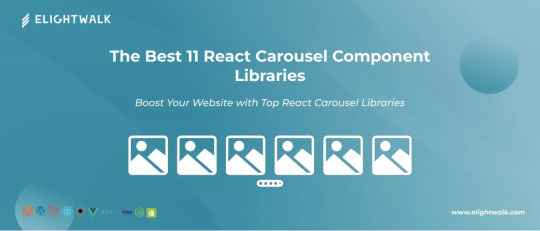
Improve your next web development project with the best React Carousel Component Libraries. Improve user experience with dynamic, interactive carousels tailored to your needs. Get expert guidance to choose the perfect library for your project!
#react carousel#React Carousel Component#react carousel library#reactjs carousel#carousel for react#Carousel Components#carousel react js#react slider carousel
1 note
·
View note
Text
Why React and PHP Work Well Together
When developing modern web applications, combining React and PHP is often a winning strategy. These two technologies complement each other, allowing developers to build dynamic, fast, and efficient web applications. Let’s explore why React and PHP work well together.
What Is React?
React is a JavaScript library used for building user interfaces, especially for single-page applications. It focuses on creating reusable UI components, making front-end development faster and more organized. React is known for its speed and ability to create highly interactive user experiences.
What Is PHP?
PHP is a server-side scripting language that powers many websites and applications. It’s widely used to handle back-end logic, manage databases, and deliver content to web pages. PHP is especially popular for its simplicity and integration with databases like MySQL.
Why Use React and PHP Together?
React and PHP have distinct roles in web development. Here’s why they work well together:
1. Separation of Front-End and Back-End
React handles the front-end, ensuring a seamless and interactive user experience. PHP works in the back-end, managing data processing, database interactions, and business logic. This separation allows developers to build robust, scalable applications.
2. Dynamic Content Delivery
PHP can generate dynamic content on the server side, such as user-specific data. React can then render this data on the front-end without refreshing the entire page, thanks to its virtual DOM.
3. API Integration
React communicates with PHP through APIs. PHP can expose RESTful APIs, which React uses to fetch and display data. This integration allows for a clear distinction between front-end and back-end responsibilities.
4. Scalability
Using React for the front-end ensures that your application is highly responsive, while PHP's robust server-side capabilities support scalability. Together, they handle growing user demands efficiently.
5. Flexibility in Deployment
React and PHP can be deployed independently. For instance, React can run on a different server from PHP, enabling flexible and modular development.
Benefits of Combining React and PHP
1. Improved User Experience
React enables fast and interactive user interfaces, while PHP processes data quickly in the back-end. This combination ensures a smooth and responsive experience for users.
2. Reusability
React components can be reused across the application, reducing development time. PHP’s functions and classes can also be reused, making the development process efficient.
3. Cost-Effectiveness
Both React and PHP are open-source technologies, which means no licensing costs. They also have large communities, providing plenty of free resources and tools for developers.
4. Easier Debugging
React's developer tools make debugging front-end code simple, while PHP’s error reporting features help identify back-end issues quickly.
Example Use Case
Consider an e-commerce website:
React: Creates a visually appealing and interactive user interface, such as product carousels, filters, and dynamic shopping carts.
PHP: Handles tasks like user authentication, order processing, and database management.
This division ensures the site is fast, scalable, and user-friendly.
Final Thoughts
Combining React and PHP is a smart choice for building modern, dynamic, and scalable web applications. React’s ability to create seamless user interfaces, paired with PHP’s robust back-end capabilities, ensures an efficient and high-performing application. Whether you’re building an e-commerce platform, a content management system, or any custom web solution, this duo can help you achieve your goals effectively.
If you're ready to take your web application to the next level, it’s time to hire React developers who can expertly integrate these technologies and deliver a top-notch solution tailored to your needs.
0 notes
Text
What is the Difference Between a React Component and a WordPress Gutenberg Block?
In the world of web development, there are countless tools and technologies at our disposal, each designed to solve specific problems or enhance certain aspects of the user experience. Two such powerful tools are React components and WordPress Gutenberg blocks. While they may seem similar at first glance, especially since both can be used to build dynamic and interactive content, their purposes, structures, and uses differ significantly. Let’s dive into their differences and understand how they fit into the broader picture of web development.

The Journey Begins:
Understanding React Components
Imagine you’re an artist, and you have a collection of brushes, each designed for a specific stroke or effect. In the world of front-end development, React components are those brushes. React, a JavaScript library developed by Facebook, is all about building user interfaces, particularly for single-page applications (SPAs). Its components are the reusable, isolated pieces of code that serve as the building blocks of an application.
Each React component is like a self-contained module that controls its own structure, style, and behavior. These components can manage their own state and lifecycle, allowing developers to create complex user interfaces by simply combining different components like Lego blocks. Whether it’s a button, a form, or an entire section of a page, React components can handle it all.
For instance, consider building a web application that requires a dynamic list of items where users can add, remove, or edit entries. React components excel in such scenarios, where the content is dynamic, and user interactions dictate the behavior of the application. The beauty of React lies in its ability to update the user interface efficiently, re-rendering only the components that have changed, which results in a seamless and fast user experience.
The Gutenberg Adventure: Entering the WordPress World
Now, let’s switch gears and step into the vast ecosystem of WordPress, the most popular content management system (CMS) globally. When WordPress introduced the Gutenberg editor, it marked a significant shift in how content was created and managed on the platform. Gutenberg blocks are the foundational elements of this new editor, enabling users to build rich content layouts with ease.
Gutenberg blocks are designed with content creators in mind. Each block represents a piece of content — be it a paragraph, image, heading, or even a more complex widget like a product carousel. Unlike React components, which are primarily used in custom web applications, Gutenberg blocks are tightly integrated with WordPress, allowing non-developers to build and manage content visually.
For example, if you’re running an online store with WooCommerce, Gutenberg blocks make it easy to add product galleries, testimonials, or featured product sections to your pages. With the drag-and-drop interface, you can arrange these blocks to create a compelling layout without writing a single line of code.
The Crossroads:
React vs. Gutenberg Blocks
At this point, you might be wondering where the line is drawn between React components and Gutenberg blocks. Here’s where the distinction becomes clear:
Purpose and Usage:
React Components: Designed for building complex, interactive web applications. They are ideal for projects that require dynamic content and user interaction, often beyond the scope of traditional content management systems.
Gutenberg Blocks: Built specifically for WordPress, these blocks simplify content creation for non-technical users. They are perfect for assembling and managing content on WordPress sites, especially when customization and ease of use are priorities.
2. Development Context:
. React Components: React is a library, meaning you can use its components in various environments, not just WordPress. This flexibility makes it a go-to choice for developers building SPAs, dashboards, or any application where performance and scalability are key concerns.
. Gutenberg Blocks: While Gutenberg blocks can be customized using React (as Gutenberg itself is built with React), they are inherently tied to WordPress. Their primary purpose is to empower content creators within the WordPress ecosystem, providing a visual and intuitive way to manage site content.
3. Reusability and Integration:
React Components: Components are highly reusable across different parts of an application. They can also be shared across projects, thanks to libraries like npm. This makes them ideal for building large-scale applications where consistency and code reuse are important.
Gutenberg Blocks: Blocks are reusable within the WordPress context, but their reusability is more about consistency in content layout rather than code. They are integrated directly into the WordPress editor, making them accessible to anyone managing content on a WordPress site.
The Conclusion:
Choosing the Right Tool for the Job
In the grand scheme of web development, both React components and Gutenberg blocks play crucial roles. React components are your best bet when building dynamic web applications where performance, scalability, and user interaction are paramount. On the other hand, Gutenberg blocks shine in the WordPress realm, where content management and user-friendly interfaces are the focus.
As we navigate the ever-evolving landscape of web development, it’s essential to understand these tools’ unique strengths and how they can be leveraged to create compelling, user-centric digital experiences.
And speaking of leveraging the best tools for the job, if you’re looking to build web applications or websites using ReactJS and WordPress, including WooCommerce, MoizWordPress has the expertise to bring your vision to life. Whether it’s a custom application that requires intricate React components or a beautifully crafted WordPress site with Gutenberg blocks, MoizWordPress can help you create something truly remarkable.
With the right team and the right tools, the possibilities are endless.
Whether you’re an artist with a brush or a developer with a component, the digital canvas is yours to shape.
#design#business#seoWork#websiteDesign#websiteDevelopment#website#websitedevelopment#digitalMarketing#seoServices#seoexecutive#increaseRanking#increaseTraffic#WebDesignTrends#UXDesign#DigitalExperience#WebsiteDevelopment#UserInterface#TechTrends#MoizWordpress#reactjs#react hooks
1 note
·
View note
Text
Swiper carousel unpkg

#Swiper carousel unpkg free
From version 2.4.0, it requires Swiper ver >= 5.0.Find more info about Swiper custom build HERE.swiperswipeslidertouchiosmobilecordovaphonegapappframeworkframework7carousel. You can also use Swiper's original params too. Most modern mobile touch slider and framework with hardware accelerated.If you want to use Swiper custom build to reduce bundle size, you need to use extra props below. Swiper is not compatible with all platforms, it is a modern touch slider which is focused only on modern apps/platforms to bring the best experience and simplicity. Designed mostly for iOS, but also works great on latest Android, Windows Phone 8 and modern Desktop browsers. If you prefer CDN, just make sure constructor Swiper is defined in browser global environment. It is intended to be used in mobile websites, mobile web apps, and mobile native/hybrid apps. I wish to introduce Swiper in a project I am following using React v17.0.2 + Next.js v11.1.0 + Webpack v5.43.0 and, copying the basic docs example, I get the.
#Swiper carousel unpkg free
Swiper - is the free and most modern mobile touch slider with hardware accelerated transitions and amazing native behavior. Open Row settings by clicking the gear icon in the green toolbar. Search for the Blurb module and add it to the page. Using the Divi Builder on your page, add a section with 1 column row. A library to use Swiper as a ReactJs component Add CSS Class swiper-slide to each module.

0 notes
Text
Features of React Native That Separate it from the Rest

Hot Reloading — A Revolutionary Feature for Mobile App Development
Hot reloading is described by the development team as “a revolutionary feature for mobile app development.” This new technology enables developers to quickly and easily, push changes without having to wait for a long list of tasks to complete.
The advantages of this new and innovative framework can be summarized in just four points:
- Instantaneous Change: Developers no longer need to spend time waiting for their code changes to compile before seeing them in-app.
- Reduced Development Time: The delay between creating a change and seeing it in-app is reduced from minutes or hours, down to seconds or fractions of a second.
- Rapid Experimentation: Test new features, concepts, or designs on the fly with instant feedback from your users.
-Continuous Deployment
Advanced Tools in the Toolbox — With a Large Variety of Useful Components for Everything from Buttons to Text Input Fields and Scrollable Lists to Animated Images in Carousels.
What are some of the advanced tools in the toolbox?
You can find a wide variety of useful components for everything from buttons to text input fields.
100% Native UX — React Native Will Let You Design Apps For Both iOS and Android From A Single Codebase
React Native is a cross-platform app development framework for creating mobile applications using JavaScript. It was created by Facebook in 2013. The framework uses the same fundamental UI building blocks as regular React, but the library makes it possible to render these components on a mobile device.
Server-Side Rendering — Server-Side
Server-side rendering is a technique used to speed up the loading time of web pages because it pre-renders HTML markup on the server before it sends it to the browser. Server-side rendering allows for faster initial page load times and eliminates one round trip for layout components that are often re-requested by client-side JavaScript.
These are some features of React Native that separate it from the Rest. If you want to make a mobile application using react native then hire react native developer and start developing your app today.
0 notes
Text
MERN eCommerce From Scratch

MERN eCommerce From Scratch MERN eCommerce From Scratch There are a lot of “eCommerce” courses out there, but most use some kind of prebuilt plugin or platform. In this course, we will build a completely customized eCommerce / shopping cart application from scratch with the MERN stack with the following functionality… - Full featured shopping cart - Product reviews and ratings - Top products carousel - Product pagination - Product search feature - User profile with orders - Admin product management - Admin user management - Admin Order details page - Mark orders as delivered option - Checkout process (shipping, payment method, etc) - PayPal / credit card integration - Custom database seeder script This is not a documentation-type course. This is a jump in and get your hands dirty course where by the end, you have an actual real-world project to use and put on your portfolio. You will learn the following by completing this course.. - React with Functional Components & Hooks - React router - React-Bootstrap UI library - How to structure components - Component level state & props - Managing global state with Redux (Actions & Reducers) - Using Redux state in components (useDispatch & useSelector) - Creating an extensive back end with Express - Working with a MongoDB database and the Mongoose ODM - JWT authentication (JSON web tokens) - Creating custom authentication middleware - Custom Read the full article
0 notes
Text
Considerations for Making a CSS Framework
Around eight months ago, I started building a framework which would eventually go on to become Halfmoon. I made a post on this very website announcing the launch of the very first version. Halfmoon has been billed as a Bootstrap alternative with a built-in dark mode feature, that is especially good when it comes to building dashboards and tools. All of this still applies to the framework.
However, today I would like to talk about an area of the framework that is a bit understated. I believe our industry as a whole seriously underestimates the value of customization and user personalization, i.e. users being able to set their own design preferences. Chris has written before about knowing who a design system is made for, pointing out a spectrum of flexibility depending on who a system is meant to help.
But it’s more than design systems. Let’s talk about how Halfmoon addresses these issues because they’re important considerations for knowing which framework works best for your specific needs.
Dashboard built using Halfmoon
Who is Halfmoon for?
Before diving in, let’s address an important question: Is Halfmoon the right framework for you? Here’s a list of questions to help you answer that:
Are you building a dashboard, tool, or even a documentation website? Halfmoon has many unique components and features that are specific to these use cases.
Are you familiar with Bootstrap’s class names, but wish that the design was a bit more premium-looking?
Does your users want or expect a dark mode on your website?
Do you dislike dependencies? Halfmoon does not use jQuery, and also has no build process involving CSS preprocessors. Everything is pure, vanilla CSS and JavaScript.
Are you tired of dealing with complex build systems and front-end tooling? This ties in to the previous point. Personally, I find it difficult to deal with front-end tooling and build processes. As mentioned above, Halfmoon has no build process, so you just pull in the files (local, CDN, or npm), and start building.
If you answered yes to any (or all) of these questions, you should probably give Halfmoon a try. It is important to note however, that Halfmoon is not a UI component library for React/Vue/Angular, so you shouldn’t go into it expecting that. Moreover, if you are more fond of purely utility driven development, then Tailwind CSS is a better option for you. When it comes to CSS utilities, Halfmoon takes a middle of the road approach – there are utilities plus semantic classes for common components.
Using CSS custom properties
First, let’s get the easy stuff out of the way. CSS custom properties are incredible, and I expect them to completely replace preprocessor variables in the future. Browser support is already at a solid ~96%, and with Internet Explorer being phased out by Microsoft, they are expected to become a standard feature.
Halfmoon is built entirely using CSS variables because they provide a huge degree of customization. Now, you might immediately think that all this means is that there are a few custom properties for colors sprinkled in there, but it’s more than that. In fact, there are over 1,500 global variables in Halfmoon. Almost everything can be customized by overriding a property. Here’s a nifty example from the docs:
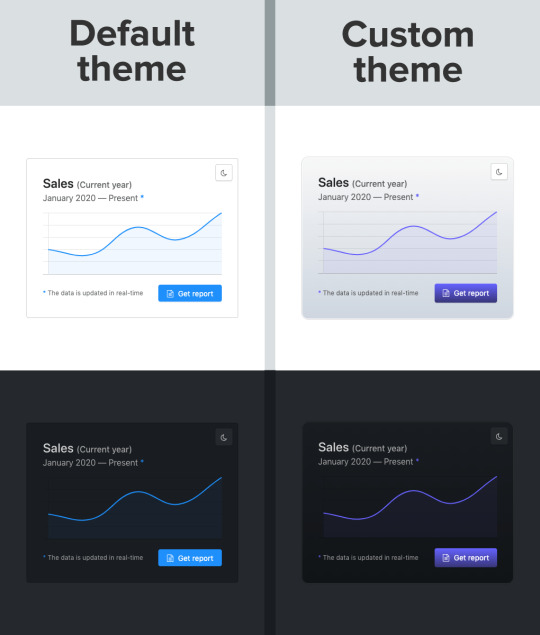
Swapping out a few custom property values opens up a ton of possibilities in Halfmoon, whether it’s theming things for a brand, or tweaking the UI to get just the right look.
That’s what we’re talking about here when it comes to customization: does the system still stand up and work well if the person using it overrides anything. I have written extensively about this (and much more) in the official Halfmoon docs page.
Variables aren’t a new concept to frameworks. Many frameworks actually use Sass or Less variables and have done so for quite a while. That’s still a good and effective way to establish a customizable experience. But at the same time, those will lock into a preprocessor (which, again, doesn’t have to be a bad thing). By relying instead on CSS custom properties — and variable-izing all the things — we are relying on native CSS, and that doesn’t require any sort of build dependency. So, not only can custom properties make it easier to customize a framework, but they are much more flexible in terms of the tech stack being used.
There is a balance to be had. I know I suggested creating variables for everything, but it can be equally tough to manage and maintain scores and scores of variables (just like anything else in the codebase). So, lean heavily on variables to make a framework or design system more flexible, but also be mindful of how much flexibility you need to provide and whether adding another variable is part of that scope.
Deciding what components to include
When it comes to building a CSS framework, deciding what components to include is a big part of that ordeal. Of course, for a developer working on a passion project, you want to include everything. But that is simply not feasible, so a few decisions were made on my part.
As of right now, Halfmoon has most of the components you can find in similar frameworks such as Bootstrap or Bulma. These frameworks are great and widely used, so they are a good frame of reference. However, as I have mentioned already, a unique thing about Halfmoon is the focus on building tools and dashboards on the web. This niche, if you could call it that, has led me to build some unique components and features:
5 different types of sidebars, with built-in toggle and overlay handlers. Sidebars are very important for most dashboards and tools (and a pain to get right), so this was a no brainer.
2 different types of navbars. There is one that sticks to the bottom of the page, which can be used to great effect for action buttons. Think about the actions that pop up when you select items on data-table. You could place those action buttons here.
Omni-directional dropdowns (with 12 different placements, 3 for each direction).
Beautiful form components.
Built-in keyboard shortcut system, with an easy way to declare new ones for your tool.
Tons of utilities. Of course, this is not comparable to Tailwind CSS, but Halfmoon has enough responsive utility classes to handle a lot of use cases right out of the box.
Moreover, the built-in dark mode, huge customizability, and the standard look and feel to the components, should all work together to make Halfmoon a great tool for building web tools and dashboards. And I am hopefully nowhere close to being done! The next updates will bring in a form validator (demo video), more form components, multi-select component, date and time picker, data-table component, etc.
So what is exactly missing from Halfmoon? Well the most obvious ones are tabs, list group, and spinners. But all of these are planned to be added in v1.2.0, which is the next update. There are also other missing components such as carousels, tree navigation, avatars, etc, which are slightly out of scope.
Providing user preferences
Giving end users the ability to set their preferences is often overlooked by frameworks. Things like setting the font size of an article, or whether to use a dark or light theme. In some ways, it’s sort of funny, because the web is catching up to what operating systems have allowed users to do for decades.
Here are some examples of user personalization on the web:
Being able to select your preferred color mode. And, even better, the website automatically saves and respects your preference when the page is loaded. Or better yet, looking at your operating system preferences and automatically accommodating them.
Setting the default size of elements. Especially font size. A small font might look good in a design, but allowing users to set their ideal font size makes the content actually readable. Technically, every modern browser has an option to zoom into content, but that is often unwieldy, and does not actually save your settings.
Setting the compactness of elements. For example, some people prefer large padding with rounded corners, while others find it a waste of space, instead preferring a tighter UI. Sort of like how Gmail lets you decide whether you want a lot of breathing room in your inbox or make it as small and tight as possible to see more content.
Setting the primary color on the website. While this is entirely cosmetic, it is still charming to be able to set your favorite color on every button and link on a website.
Enabling a high contrast mode. Someone pointed this out to me on GitHub. Apparently, many (and I mean many) CSS frameworks often fail the minimum contrast recommended between foreground and background colors on common elements, such as buttons. That list includes Halfmoon. This is often a tradeoff, because overly contrastive elements often look worse (purely in terms of aesthetic). User personalization can allow you to turn on a high contrast mode, if you have difficulty with the default contrast.
Allowing for user personalizations can be really difficult to pull off — especially for a framework — because that would could mean swapping out huge parts of CSS to accommodate the different personalization settings and combinations. However, with a framework like Halfmoon (i.e. built entirely using CSS variables), this becomes trivial as CSS variables can be set and changed on run-time using JavaScript, like so:
// Get the <html> tag (for reading and setting variables in global scope) var myElement = document.documentElement; // Read CSS variable getComputedStyle(myElement).getPropertyValue("--variable-name"); // Set CSS variable myElement.style.setProperty("--variable-name", "value");
Therefore, user personalization can be implemented using Halfmoon in the following way:
The user sets a preference. That basically means a variable value gets changed. The variable is set with JavaScript (as shown above), and the new value is stored in a cookie or local storage.
When the user comes back to the website, their preferences are retrieved and set using JavaScript (again, as shown above) once the page is loaded.
Here are visual examples to really hammer the point home.
Setting and saving the default font size
In the example above, whenever the range slider is changed, the variable --base-font-size is updated to the slider’s value. This is great for people who prefer larger text. As explained in the previous section, this new value can be saved in a cookie or local storage, and the next time the user visits the website, the user preference can be set on page load.
Setting the compactness of content

Because there are CSS custom properties used as utilities, like spacing and borders, we can remove or override them easily to create a more compact or expanded component layout.
Only two variables are updated in this example to go from an expanded view to a compact one:
--content-and-card-spacing changed from 3rem (30px) to 2rem (20px).
--card-border-radius changed from 0.4rem (4px) to 0.2rem (2px).
For a real life scenario, you could have a dropdown that asks the user whether they prefer their content to be Default or Compact, and choosing one would obviously set the above CSS variables to theme the site. Once again, this could be saved and set on page load when the user visits the website on their next session.
Wait, but why?
Even with all the examples I have shown so far, you may still be asking why is this actually necessary. The answer is really simple: one size does not fit all. In my estimate, around half of the population prefers a dark UI, while the other half prefers light. Similarly, people have wild variations about the things they like when it comes to design. User personalization is a form of improving the UX, because it lets the user choose what they prefer. This may not be so important on a landing page, but when it comes to a tool or dashboard (that one has to use for a long time to get something done), having a UI that can be personalized is a boon to productivity. And knowing that is what Halfmoon is designed to do makes it ideal for these types of use cases.
Moreover, you know how people often complain that websites made with a certain framework (eg Bootstrap) all look the same? This is a step toward making sure that websites built with Halfmoon will always look distinct, so that the focus is on the website and content itself, and not on the framework that was used to build it.
Again, I am not saying that everything should be allowed to be personalized. But knowing who the framework is for and what it is designed to do helps make it clear what should be personalized.
Looking ahead
I strongly feel that flexibility for customization and accounting for user preferences are often overlooked on the web, especially in the framework landscape. That’s what I’m trying to address with Halfmoon.
In the future, I want to make it a lot easier for developers to implement user preferences, and also promote diversity of design with new templates and themes. That said, here are some things on the horizon for Halfmoon:
A form validator (demo video)
New components, including range sliders, tabs and spinners
High contrast mode user preference
Multi-select component (like Select2, only without jQuery)
A date and time picker
A data-table component
A GUI-based form builder
More themes and templates
You can, of course, learn more about Halfmoon in the documentation website, and if you want to follow the project, you can give it a star on GitHub.
The post Considerations for Making a CSS Framework appeared first on CSS-Tricks.
You can support CSS-Tricks by being an MVP Supporter.
Considerations for Making a CSS Framework published first on https://deskbysnafu.tumblr.com/
0 notes
Text
Top 10 React Carousel Component Libraries and their Usage Trends
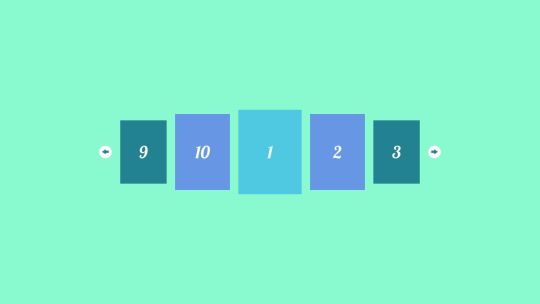
Nowadays, it has become crucial to create a visually appealing and engaging user interface whenever you think about developing web applications or websites. An innovative way to get it is by adding carousels to the web applications. It helps the developers to display the products and services in a more organized way. So, this way, your website can look clutter-free and catch the attention of potential visitors. There are several front-end frameworks available. But, among them, React is one of the most popular and used frameworks as it is a component-based architecture and can be used for reusability.
If you want to know about the top 10 libraries, this guide will be helpful for you. It will further explore the features, usability, and performance of those libraries. However, you need to hire React JS developer who has experience and proper knowledge of React carousel component libraries.
Top 10 React Carousel Component Libraries
There are various React carousel component libraries. Discussed here are the top 10 React carousel component libraries:
1. React Slick
One of the most famous carousel component libraries for React is React Slick. This specific library is developed on top of the Slick carousel library. The React Slick provides several customization options to use the users. This even gives complete assistance for your well-responsive website design along with all the innovative transition effects. With its simple API for integration, it has become the most preferable option for developers.

2. Swiper
Another unique and secure carousel component library is Swiper. With it, you can do customization to the highest level. This flexible carousel library also accepts swipe gestures and touch with mouse wheel control and keyboard navigation. The effortless animations and performance of this carousel component library make it a great choice to create engaging carousels in React applications.

3. React-Responsive-Carousel
If you are looking for a well-responsive and lightweight carousel component, you can count on the React-Responsive-Carousel. It comes up with a simple API to produce the carousels. With it, you can also receive customizable transition effects and the autoplay feature. Because of this, you can pick this to use it for different cases.

4. Glide.js
Glide.js can be a top carousel library for React as it is touch-friendly and well-responsive. You can use it to get a lightweight and a minimalistic solution to create carousels with exceptional performance and smoother transitions. This specific component library is suitable for those projects that need increased performance and more simplicity with all the essential features.

5. Alice Carousel
With the help of Alice Carousel, you can create carousels with fluid animations and effortless navigation. The best part of the Alice Carousel is that it can support both the vertical and horizontal orientations. Even, it supports the ever-ending looping and slow loading of the images. So, all these features make this a carousel solution.

6. React-Id-Swiper
Another feature-rich and powerful carousel library is React-Id-Swiper. As it has the ability to offer a comprehensive option to create the carousels with different effects and slow loading, it can be an ideal choice. Besides this, it is also an excellent pick for projects requiring advanced carousel functionalities.

7. Embla Carousel
You may select the Embla Carousel because of its customizable option and lightweight. The main goal of this carousel component library is to offer easy API to make carousels with horizontal and vertical scrolling, frequent looping and drag-and-snap navigation. Other reasons of choosing Embla carousels are high performance and immense flexibility.

8. React-Bootstrap Carousel
Another on the list is the React-Bootstrap Carousel which can offer a set of components to build one of the most well-responsive web applications. The primary advantage of this carousel component library are that it provides many features such as support for several content types. Slide indicators, navigation control, etc. It is an ideal choice for projects utilizing the React-Bootstrap framework.

9. Pure React Carousel
Choosing the Pure React Carousel will be helpful because of its lightweight and customizable carousel components for React. This provides a more accessible and simple option to create the image carousels. It comes up with important features like autoplay, keyboard navigation, and touch support. So, all these crucial features make it a perfect pick for all those projects that have simple carousel requirements.

10. React Alice Carousel
Inspired by the Alice Carousel library, the React Alice Carousel is another top react carousel component with several features. This specific component offers constant looping, several transition effects, and well-responsive designs.

Evaluation of Libraries Based on Criteria
You can choose a React carousel component library depending on your specific criteria. Discussed below are some tips on how to do so. If you hire React JS developer, you should discuss your specific criteria with them.
1. Ease of Integration
Regarding ease of integration, React Slick, React-Responsive-Carousel, and React-Bootstrap Carousel are the top choices. It is because all these components provide seamless integration with the React application with simple APIs. Besides this, these libraries provide are best for clear documentation and examples.
2. Customization Options
You can choose the Swiper, Glide.js, and Embla Carousel because they offer highest-level customization options for transitions, animations, and styles. All these libraries provide the APIs to support carousel behavior and appearance. So, it helps the developers create unique and attention-catching carousels tailored to their project requirements.
3. Performance Metrics
Performance-wise, Glide.js and Embla Carousel excel in providing lightweight and performant carousel solutions. These libraries prioritize smooth animations and minimal overhead, resulting in efficient rendering and memory usage. Swiper also demonstrates excellent performance, especially on mobile devices with its hardware-accelerated transitions.
4. Touch and Swipe Gestures
Swiper, React-Id-Swiper, and Alice Carousel lead the pack in terms of touch and swipe gesture support. These libraries offer seamless touch interactions, ensuring a smooth user experience on both desktop and mobile devices. They also provide options for configuring swipe sensitivity and touch behavior, catering to diverse user preferences.
5. Accessibility and Web Standards
React-Responsive-Carousel and Pure React Carousel emphasize accessibility features and compliance with web standards. These libraries prioritize keyboard navigation, screen reader support, and semantic markup, ensuring that carousels are usable and accessible to all users, including those with disabilities.
6. Community Support and Maintenance
React Slick, Swiper, and React-Id-Swiper benefit from active community support and regular maintenance. These libraries have a large user base, extensive documentation, and ongoing development, indicating their reliability and long-term viability for integrating carousels into React applications.
Conclusion
The web developers can never overemphasize the importance of the React carousel component libraries. So, this guide discusses the best 10 React carousel component libraries with several features and capabilities. However, when choosing a component library, research properly because every library comes up with distinctive features.
So, choose a carousel component library that will be useful for your projects. Then, Hire dedicated React JS developer who has proper knowledge, skills, and experience in React carousel component library.
Content Source: Boost Your Website with Top React Carousel Libraries | BOSC
#hire react developers#hire dedicated react developers#hire react js consultants#React Carousel Component Libraries#React Slick#React applications#web applications#React-Bootstrap Carousel#Hire dedicated React JS developer
0 notes
Link

JavaScript is one of the most popular languages on the web. Even though it was initially developed just for web pages, it has seen exponential growth in the past two decades.
Now, JavaScript is capable of doing almost anything and works on several platforms and devices including IoT. And with the recent SpaceX Dragon launch, JavaScript is even in space.
One of the reasons for its popularity is the availability of a large number of frameworks and libraries. They make development much easier compared to traditional Vanilla JS development.
There are libraries for almost anything and more are coming out almost every day. But with so many libraries to choose from it becomes difficult to keep a track of each one and how it might be tailored specifically to your needs.
In this article, we will discuss 10 of the most popular JS libraries which you can use to build your next project.
Leaflet
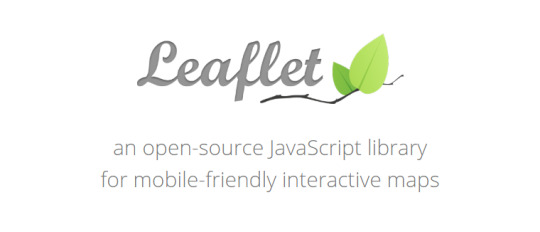
Leaflet
I think Leaflet is the best open source library for adding mobile-friendly interactive maps to your application.
Its small size (39kB) makes it a great alternative to consider over other map libraries. With cross-platform efficiency and a well-documented API, it has everything you need to make you fall in love.
Here is some sample code that creates a Leaflet map:
var map = new L.Map("map", { center: new L.LatLng(40.7401, -73.9891), zoom: 12, layers: new L.TileLayer("https://tile.openstreetmap.org/{z}/{x}/{y}.png") });
In Leaflet, we need to provide a tile layer since there isn't one by default. But that also means that can choose from a wide range of layers both free and premium. You can explore various free tile layers here.
Read the Docs or follow the Tutorials to learn more.
fullPage.js
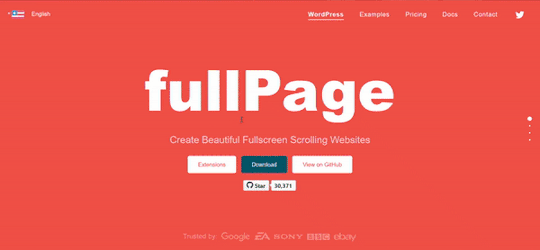
This open-source library helps you create full-screen scrolling websites as you can see in the above GIF. It's easy to use and has many options to customize, so it's no surprise it is used by thousands of developers and has over 30k stars on GitHub.
Here is a Codepen demo that you can play with:
You can even use it with popular frameworks such as:
react-fullpage
vue-fullpage
angular-fullpage
I came across this library about a year ago and since then it has become one of my favorites. This is one of the few libraries that you can use in almost every project. If you haven't already started using it then just try it, you will not be disappointed.
anime.js
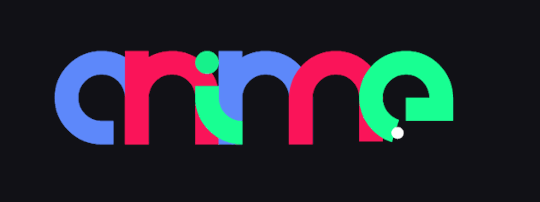
anime.js
One of the best animation libraries out there, Anime.js is flexible and simple to use. It is the perfect tool to help you add some really cool animation to your project.
Anime.js works well with CSS properties, SVG, DOM attributes, and JavaScript Objects and can be easily integrated into your applications.
As a developer it's important to have a good portfolio. The first impression people have of your portfolio helps decide whether they will hire you or not. And what better tool than this library to bring life to your portfolio. It will not only enhance your website but will help showcase actual skills.
Check out this Codepen to learn more:
You can also take a look at all the other cool projects on Codepen or Read the Docs here.
Screenfull.js

screenfull.js
I came across this library while searching for a way to implement a full-screen feature in my project.
If you also want to have a full-screen feature, I would recommend using this library instead of Fullscreen API because of its cross-browser efficiency (although it is built on top of that).
It is so small that you won't even notice it – just about 0.7kB gzipped.
Try the Demo or read the Docs to learn more.
Moment.js
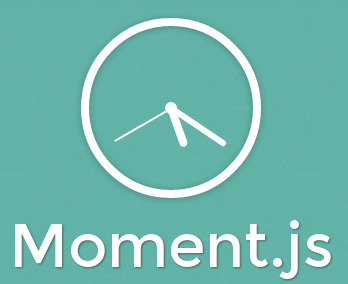
Moment.js
Working with date and time can be a huge pain, especially with API calls, different Time Zones, local languages, and so on. Moment.js can help you solve all those issues whether it is manipulating, validating, parsing, or formatting dates or time.
There are so many cool methods that are really useful for your projects. For example, I used the .fromNow() method in one of my blog projects to show the time the article was published.
const moment = require('moment'); relativeTimeOfPost = moment([2019, 07, 13]).fromNow(); // a year ago
Although I don't use it very often, I am a fan of its support for internationalization. For example, we can customize the above result using the .locale() method.
// French moment.locale('fr'); relativeTimeOfPostInFrench = moment([2019, 07, 13]).fromNow(); //il y a un an // Spanish moment.locale('es'); relativeTimeOfPostInSpanish = moment([2019, 07, 13]).fromNow(); //hace un año
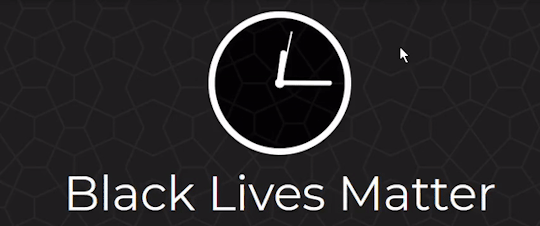
Moment.js Homepage
Read the Docs here.
Hammer.js
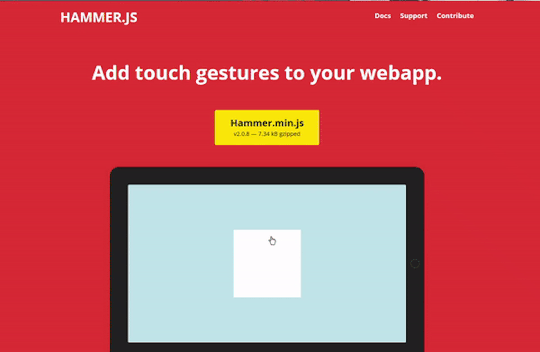
Hammer.js is a lightweight JavaScript library that lets you add multi-touch gestures to your Web Apps.
I would recommend this library to add some fun to your components. Here is an example to play with. Just run the pen and tap or click on the grey div.
It can recognize gestures made by touch, mouse and pointerEvents. For jQuery users I would recommend using the jQuery plugin.
$(element).hammer(options).bind("pan", myPanHandler);
Read the Docs here.
Masonry
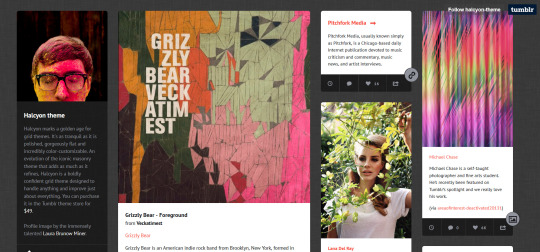
Masonry
Masonry is a JavaScript grid layout library. It is super awesome and I use it for many of my projects. It can take your simple grid elements and place them based on the available vertical space, sort of like how contractors fit stones or blocks into a wall.
You can use this library to show your projects in a different light. Use it with cards, images, modals, and so on.
Here is a simple example to show you the magic in action. Well, not magic exactly, but how the layout changes when you zoom in on the web page.
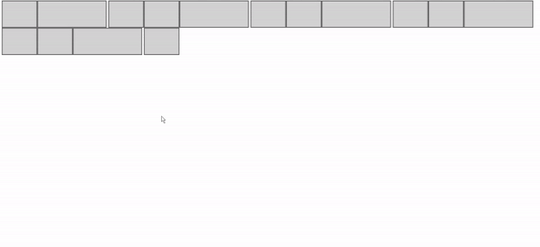
And here is the code for the above:
var elem = document.querySelector('.grid'); var msnry = new Masonry( elem, { itemSelector: '.grid-item', columnWidth: 400 }); var msnry = new Masonry( '.grid');
Here is a cool demo on Codepen:
Check out these Projects
https://halcyon-theme.tumblr.com/
https://tympanus.net/Development/GridLoadingEffects/index.html
https://www.erikjo.com/work
D3.js
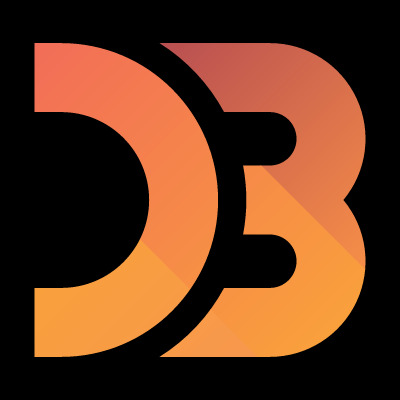
If you are a data-obsessed developer then this library is for you. I have yet to find a library that manipulates data as efficiently and beautifully as D3. With over 92k stars on GitHub, D3 is the favorite data visualization library of many developers.
I recently used D3 to visualize COVID-19 data with React and the Johns Hopkins CSSE Data Repository on GitHub. It I was a really interesting project, and if you are thinking of doing something similar, I would suggest giving D3.js a try.
Read more about it here.
slick
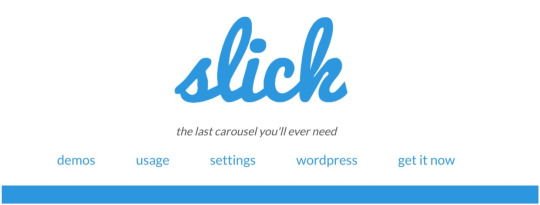
slick
Slick is fully responsive, swipe-enabled, infinite looping, and more. As mentioned on the homepage it truly is the last carousel you'll ever need.
I have been using this library for quite a while, and it has saved me so much time. With just a few lines of code, you can add so many features to your carousel.
$('.autoplay').slick({ slidesToShow: 3, slidesToScroll: 1, autoplay: true, autoplaySpeed: 2000, });

Autoplay
Check out the demos here.
Popper.js
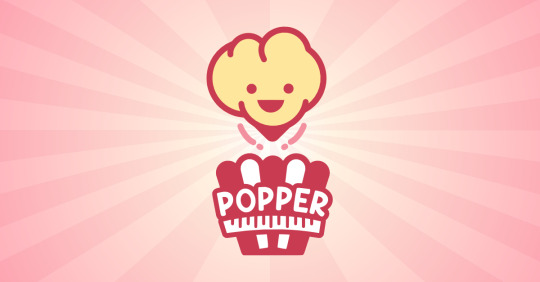
Popper.js
Popper.js is a lightweight ~3 kB JavaScript library with zero dependencies that provides a reliable and extensible positioning engine you can use to ensure all your popper elements are positioned in the right place.
It may not seem important to spend time configuring popper elements, but these little things are what make you stand out as a developer. And with such small size it doesn't take up much space.
Read the Docs here.
Conclusion
As a developer, having and using the right JavaScript libraries is important. It will make you more productive and will make development much easier and faster. In the end, it is up to you which library to prefer based on your needs.
These are 10 JavaScript libraries that you can try and start using in your projects today. What other cool JavaScript libraries you use? Would you like another article like this? Tweet and let me know.
0 notes
Text
7 Best Material Design UI Component Libraries
Material design is a popular visual design system created by Google. It aims to enable designers and developers to create applications that have a unified look on all platforms. Apps that follow material design principles look beautiful and professional on all operating systems and devices. Google’s official material design toolkit supplies you with many assets such as guidelines, components, color palettes, themes, and icons.
However, that’s just the beginning. As material design is an open-source project, third-party developers have also created their own tools following material design principles. In this article, we have collected the best material design UI component libraries that can help you a lot in your next web or mobile app project.
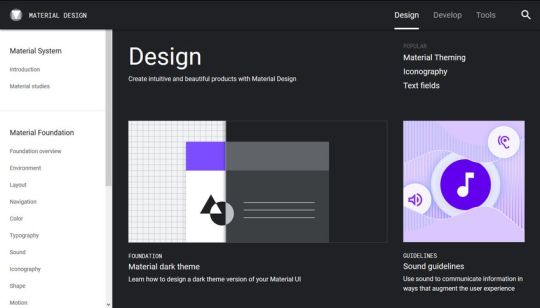
Google’s material design guidelines at Material.io
Material Design Principles
Before getting started with the best material design UI component libraries, let’s have a quick glance at the most important material design principles. They are as follows:
material color palettes typically use a primary and a secondary color,
colors need to indicate the state of components and the relationship between them,
text and icons should meet legibility standards,
motion on the screen always needs to have a meaning,
components should be reusable,
icons should have clean folds and crisp edges,
and many others.
Google made a thorough research to create the material design system and it takes some time to go through the guidelines. And, this is where the best material design UI component libraries can help you a lot. If you find one you like, you don’t have to be a material design expert to create apps that follow Google’s material guidelines.
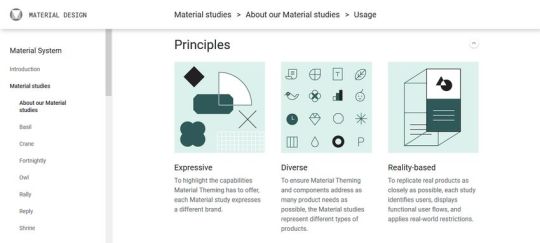
Sample from Google’s material design guidelines
The Best Material Design UI Component Libraries
Now, let’s see the best material design UI component libraries. Although you can use them for regular web development, too, they fit espcially well with Web Components and component-based JavaScript libraries such as React, Vue, Angular, and others.
1. Materialize
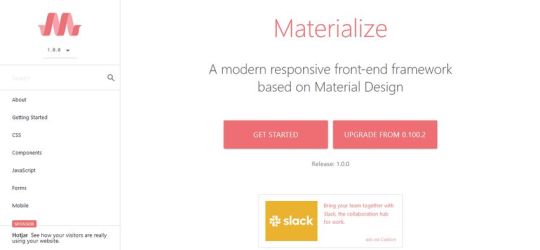
Materialize is a responsive CSS framework that follows the principles of material design. It provides you with multiple ready-to-use components such as badges, buttons, breadcrumbs, cards, icons, navigation bars, and more. Besides elements typical to websites, Materialize also includes mobile app components such as a cool drag-out menu and unobtrusive mobile alerts.
All Materialize components come with code examples you only need to add to your HTML page. Besides HTML and CSS components, you also get access to a number of customizable JavaScript elements such as a carousel, modals, parallax effects, and others. The team behind Materialize also offers themes that have been created with the component library, however they charge $19.00 – $49.00 per theme (or you can get the whole set for $59.99).
2. Material Design for Bootstrap
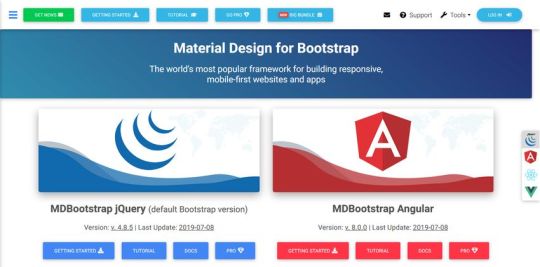
Material Design for Bootstrap is a versatile component library that allows you to build responsive, mobile-first websites and applications. It has been created for the Bootstrap 4 framework to help you use both front-end technologies at the same time. The default config uses jQuery for interactivity, however, the library also has setups for the three most popular JS frameworks: Angular, React, and Vue.
It has both a free and premium version. You can download the free material UI kit from GitHub. Currently, it includes 400+ material UI elements, 600+ material icons, 74 CSS animations, tutorials, and pre-made templates. Although the free library is more than enough for most apps, the pro version contains 4500+ premium components, 50+ premium sections, plugins, and JS modularity, too.
3. Material UI (for React)
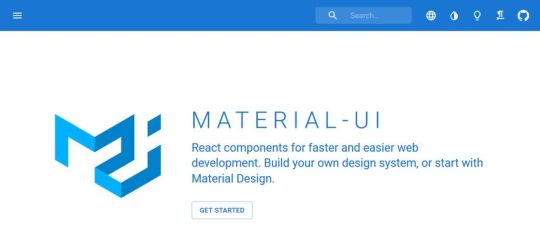
Material UI is a popular UI component library for the React framework. If you want to create any kind of React app with a material look and feel, you need not go further. The components of Material UI work out of the box, they don’t require any additional configuration. The library includes layout components, all kinds of input elements, navigation bars, surfaces, utilities, and more. For the full list of components, take a look at the documentation.
Besides having access to multiple pre-designed components, Material UI also provides you with an extensive Component API. It lets you customize all the components with the help of props and CSS customization points. Material UI’s docs are really good and easy-to-follow, with a lot of examples, code snippets, and demos, so you can quickly get started with prototyping.
4. Vue Material
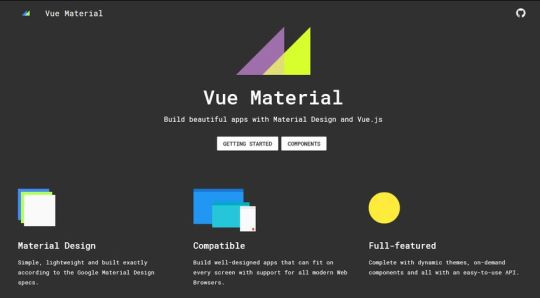
Vue Material is a lightweight material design UI component library for the Vue.js framework. Its creators take pride in having built all the components exactly according to Google’s material design specifications. Vue Material comes with tons of pre-designed UI elements such as avatars, buttons, cards, dialogs, forms, icons, lists, toolbars, and many more.
As Vue Material is pretty well-documented, it’s easy to get started with it if you worked with HTML, CSS, and Vue before. Each component is published within a live sandbox so that you can change the code online and see the results in real-time. Vue Material is a free UI component library that comes with two themes: Vue Material Dashboard Free including 16 components and the full-featured Vue Material Dashboard Pro for $59.00.
5. Angular Material
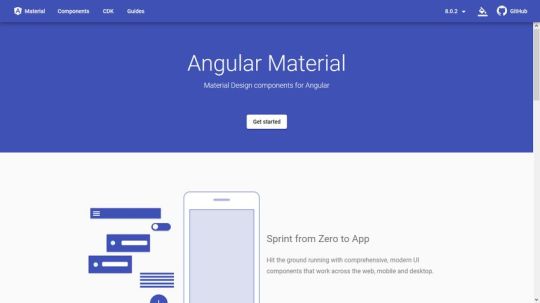
If you are on the look for a material design UI component library for your Angular application, Angular Material can be a good solution for you. It has been created by Google for the Angular 2 framework and it’s still under active development. Besides multiple UI components, Angular Material also includes the Angular Component Development Kit (CDK). Angular CDK is a toolkit that implements common interaction patterns such as accessibility, bi-directionality, drag-and-drop functionality, scrolling, and others.
Angular Material allows you to quickly prototype the user interface of any Angular application by providing you with professionally designed components created by Google. The components are categorized into six groups:
form controls,
navigation,
layout,
buttons & indicators,
popups & modals,
and data table for tabular data.
The library also comes with detailed guides that explain everything you need to know about building UIs with Angular Material.
6. MUI CSS

MUI CSS is a lightweight material design UI component library that includes the most important components you need in a website or application. You only need to add a minified CSS (6.6 kbyte) and JavaScript (5.4 kybte) file to your HTML page. As MUI CSS doesn’t have any external dependencies, it’s easy to set it up, even for beginners.
Besides components written in regular CSS and JS, MUI CSS has ready-to-use UI elements for React and Angular apps. The MUI CSS team has also begun to develop the beta version of a Web Components library, currently with three types of components: a HTML boilerplate, buttons, and forms. In addition, MUI CSS has a cool email UI library, too, with which you can create email templates that follow the material design guidelines.
7. Material Components for the Web
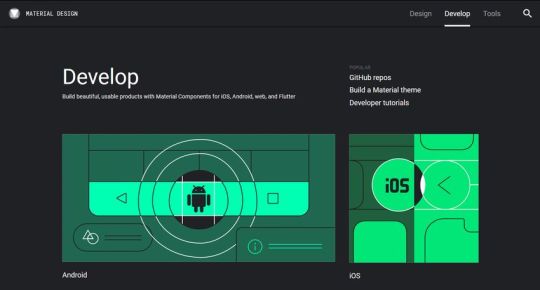
Material Components for the Web is the successor of Material Design Lite (MDL), both created by Google’s in-house team. Google’s documention on GitHub even refers the Material Components for the Web library as MDL v2. So, if you were thinking about using MDL for your project, use this library instead, as MDL vs1 is already in limited support mode.
You can find Google’s Material Components on the same material.io website where Google hosts its material design guidelines mentioned above in the article. You get access to pre-designed material UI components for four platforms:
Android,
iOS,
web,
and Flutter.
The web library provides you with a wide range of UI components such as buttons, cards, grids, surfaces, menus, tabs, and many others. If you want to create a web or mobile app that looks like Google’s own applications, the Material Components for the Web library can be the best solution for you.
Conclusion
Material design can give a professional look and feel to any web or mobile application. It’s especially a good choice if you want to build apps for the same brand for different platforms.
Creating a good-looking UI can be quite a challenge. With the best material design UI component libraries, you can follow Google’s material design guidelines without being an experienced designer.
If you are a programmer who usually works with back-end languages but want to know more about how to use UI frameworks, check out or backend developer’s guide to UI design, too.
This post comes from Digital Marketing Warrington
0 notes
Text
Best Material Design UI Component Libraries for Your Next Project
Material design is a popular visual design system created by Google. It aims to enable designers and developers to create applications that have a unified look on all platforms. Apps that follow material design principles look beautiful and professional on all operating systems and devices. Google’s official material design toolkit supplies you with many assets such as guidelines, components, color palettes, themes, and icons.
However, that’s just the beginning. As material design is an open-source project, third-party developers have also created their own tools following material design principles. In this article, we have collected the best material design UI component libraries that can help you a lot in your next web or mobile app project.
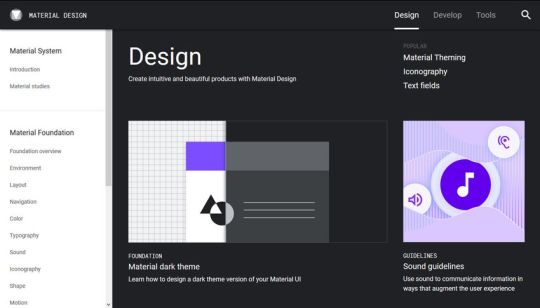
Google’s material design guidelines at Material.io
Material Design Principles
Before getting started with the best material design UI component libraries, let’s have a quick glance at the most important material design principles. They are as follows:
material color palettes typically use a primary and a secondary color,
colors need to indicate the state of components and the relationship between them,
text and icons should meet legibility standards,
motion on the screen always needs to have a meaning,
components should be reusable,
icons should have clean folds and crisp edges,
and many others.
Google made a thorough research to create the material design system and it takes some time to go through the guidelines. And, this is where the best material design UI component libraries can help you a lot. If you find one you like, you don’t have to be a material design expert to create apps that follow Google’s material guidelines.
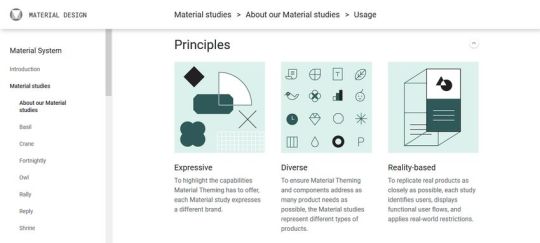
Sample from Google’s material design guidelines
The Best Material Design UI Component Libraries
Now, let’s see the best material design UI component libraries. Although you can use them for regular web development, too, they fit espcially well with Web Components and component-based JavaScript libraries such as React, Vue, Angular, and others.
1. Materialize
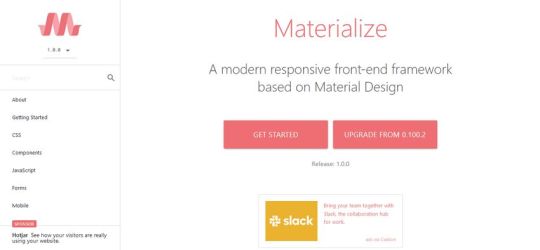
Materialize is a responsive CSS framework that follows the principles of material design. It provides you with multiple ready-to-use components such as badges, buttons, breadcrumbs, cards, icons, navigation bars, and more. Besides elements typical to websites, Materialize also includes mobile app components such as a cool drag-out menu and unobtrusive mobile alerts.
All Materialize components come with code examples you only need to add to your HTML page. Besides HTML and CSS components, you also get access to a number of customizable JavaScript elements such as a carousel, modals, parallax effects, and others. The team behind Materialize also offers themes that have been created with the component library, however they charge $19.00 – $49.00 per theme (or you can get the whole set for $59.99).
2. Material Design for Bootstrap
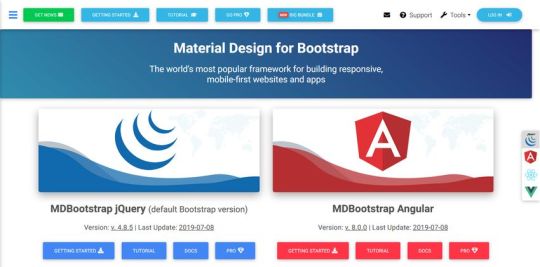
Material Design for Bootstrap is a versatile component library that allows you to build responsive, mobile-first websites and applications. It has been created for the Bootstrap 4 framework to help you use both front-end technologies at the same time. The default config uses jQuery for interactivity, however, the library also has setups for the three most popular JS frameworks: Angular, React, and Vue.
It has both a free and premium version. You can download the free material UI kit from GitHub. Currently, it includes 400+ material UI elements, 600+ material icons, 74 CSS animations, tutorials, and pre-made templates. Although the free library is more than enough for most apps, the pro version contains 4500+ premium components, 50+ premium sections, plugins, and JS modularity, too.
3. Material UI (for React)
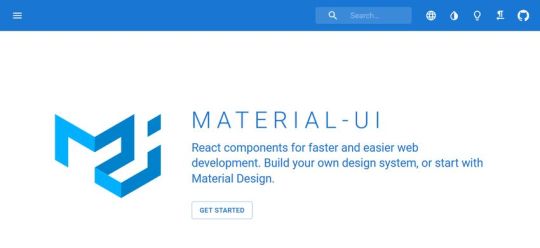
Material UI is a popular UI component library for the React framework. If you want to create any kind of React app with a material look and feel, you need not go further. The components of Material UI work out of the box, they don’t require any additional configuration. The library includes layout components, all kinds of input elements, navigation bars, surfaces, utilities, and more. For the full list of components, take a look at the documentation.
Besides having access to multiple pre-designed components, Material UI also provides you with an extensive Component API. It lets you customize all the components with the help of props and CSS customization points. Material UI’s docs are really good and easy-to-follow, with a lot of examples, code snippets, and demos, so you can quickly get started with prototyping.
4. Vue Material
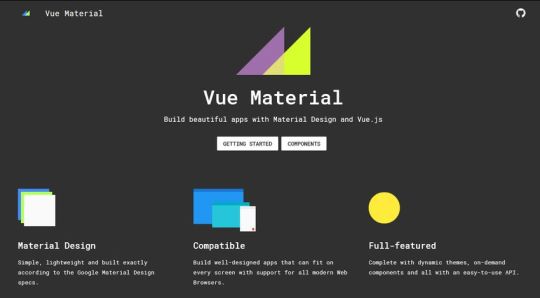
Vue Material is a lightweight material design UI component library for the Vue.js framework. Its creators take pride in having built all the components exactly according to Google’s material design specifications. Vue Material comes with tons of pre-designed UI elements such as avatars, buttons, cards, dialogs, forms, icons, lists, toolbars, and many more.
As Vue Material is pretty well-documented, it’s easy to get started with it if you worked with HTML, CSS, and Vue before. Each component is published within a live sandbox so that you can change the code online and see the results in real-time. Vue Material is a free UI component library that comes with two themes: Vue Material Dashboard Free including 16 components and the full-featured Vue Material Dashboard Pro for $59.00.
5. Angular Material
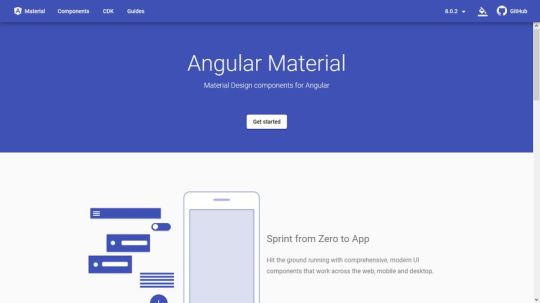
If you are on the look for a material design UI component library for your Angular application, Angular Material can be a good solution for you. It has been created by Google for the Angular 2 framework and it’s still under active development. Besides multiple UI components, Angular Material also includes the Angular Component Development Kit (CDK). Angular CDK is a toolkit that implements common interaction patterns such as accessibility, bi-directionality, drag-and-drop functionality, scrolling, and others.
Angular Material allows you to quickly prototype the user interface of any Angular application by providing you with professionally designed components created by Google. The components are categorized into six groups:
form controls,
navigation,
layout,
buttons & indicators,
popups & modals,
and data table for tabular data.
The library also comes with detailed guides that explain everything you need to know about building UIs with Angular Material.
6. MUI CSS
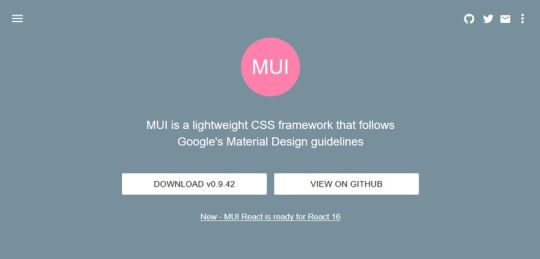
MUI CSS is a lightweight material design UI component library that includes the most important components you need in a website or application. You only need to add a minified CSS (6.6 kbyte) and JavaScript (5.4 kybte) file to your HTML page. As MUI CSS doesn’t have any external dependencies, it’s easy to set it up, even for beginners.
Besides components written in regular CSS and JS, MUI CSS has ready-to-use UI elements for React and Angular apps. The MUI CSS team has also begun to develop the beta version of a Web Components library, currently with three types of components: a HTML boilerplate, buttons, and forms. In addition, MUI CSS has a cool email UI library, too, with which you can create email templates that follow the material design guidelines.
7. Material Components for the Web
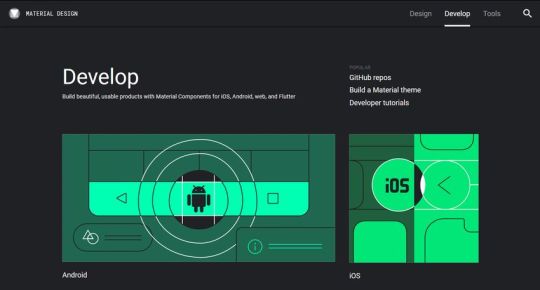
Material Components for the Web is the successor of Material Design Lite (MDL), both created by Google’s in-house team. Google’s documention on GitHub even refers the Material Components for the Web library as MDL v2. So, if you were thinking about using MDL for your project, use this library instead, as MDL vs1 is already in limited support mode.
You can find Google’s Material Components on the same material.io website where Google hosts its material design guidelines mentioned above in the article. You get access to pre-designed material UI components for four platforms:
Android,
iOS,
web,
and Flutter.
The web library provides you with a wide range of UI components such as buttons, cards, grids, surfaces, menus, tabs, and many others. If you want to create a web or mobile app that looks like Google’s own applications, the Material Components for the Web library can be the best solution for you.
Conclusion
Material design can give a professional look and feel to any web or mobile application. It’s especially a good choice if you want to build apps for the same brand for different platforms.
Creating a good-looking UI can be quite a challenge. With the best material design UI component libraries, you can follow Google’s material design guidelines without being an experienced designer.
If you are a programmer who usually works with back-end languages but want to know more about how to use UI frameworks, check out or backend developer’s guide to UI design, too.
Best Material Design UI Component Libraries for Your Next Project published first on http://7elementswd.tumblr.com/
0 notes
Text
Best Material Design UI Component Libraries for Your Next Project
Material design is a popular visual design system created by Google. It aims to enable designers and developers to create applications that have a unified look on all platforms. Apps that follow material design principles look beautiful and professional on all operating systems and devices. Google’s official material design toolkit supplies you with many assets such as guidelines, components, color palettes, themes, and icons.
However, that’s just the beginning. As material design is an open-source project, third-party developers have also created their own tools following material design principles. In this article, we have collected the best material design UI component libraries that can help you a lot in your next web or mobile app project.

Google’s material design guidelines at Material.io
Material Design Principles
Before getting started with the best material design UI component libraries, let’s have a quick glance at the most important material design principles. They are as follows:
material color palettes typically use a primary and a secondary color,
colors need to indicate the state of components and the relationship between them,
text and icons should meet legibility standards,
motion on the screen always needs to have a meaning,
components should be reusable,
icons should have clean folds and crisp edges,
and many others.
Google made a thorough research to create the material design system and it takes some time to go through the guidelines. And, this is where the best material design UI component libraries can help you a lot. If you find one you like, you don’t have to be a material design expert to create apps that follow Google’s material guidelines.

Sample from Google’s material design guidelines
The Best Material Design UI Component Libraries
Now, let’s see the best material design UI component libraries. Although you can use them for regular web development, too, they fit espcially well with Web Components and component-based JavaScript libraries such as React, Vue, Angular, and others.
1. Materialize

Materialize is a responsive CSS framework that follows the principles of material design. It provides you with multiple ready-to-use components such as badges, buttons, breadcrumbs, cards, icons, navigation bars, and more. Besides elements typical to websites, Materialize also includes mobile app components such as a cool drag-out menu and unobtrusive mobile alerts.
All Materialize components come with code examples you only need to add to your HTML page. Besides HTML and CSS components, you also get access to a number of customizable JavaScript elements such as a carousel, modals, parallax effects, and others. The team behind Materialize also offers themes that have been created with the component library, however they charge $19.00 – $49.00 per theme (or you can get the whole set for $59.99).
2. Material Design for Bootstrap

Material Design for Bootstrap is a versatile component library that allows you to build responsive, mobile-first websites and applications. It has been created for the Bootstrap 4 framework to help you use both front-end technologies at the same time. The default config uses jQuery for interactivity, however, the library also has setups for the three most popular JS frameworks: Angular, React, and Vue.
It has both a free and premium version. You can download the free material UI kit from GitHub. Currently, it includes 400+ material UI elements, 600+ material icons, 74 CSS animations, tutorials, and pre-made templates. Although the free library is more than enough for most apps, the pro version contains 4500+ premium components, 50+ premium sections, plugins, and JS modularity, too.
3. Material UI (for React)

Material UI is a popular UI component library for the React framework. If you want to create any kind of React app with a material look and feel, you need not go further. The components of Material UI work out of the box, they don’t require any additional configuration. The library includes layout components, all kinds of input elements, navigation bars, surfaces, utilities, and more. For the full list of components, take a look at the documentation.
Besides having access to multiple pre-designed components, Material UI also provides you with an extensive Component API. It lets you customize all the components with the help of props and CSS customization points. Material UI’s docs are really good and easy-to-follow, with a lot of examples, code snippets, and demos, so you can quickly get started with prototyping.
4. Vue Material

Vue Material is a lightweight material design UI component library for the Vue.js framework. Its creators take pride in having built all the components exactly according to Google’s material design specifications. Vue Material comes with tons of pre-designed UI elements such as avatars, buttons, cards, dialogs, forms, icons, lists, toolbars, and many more.
As Vue Material is pretty well-documented, it’s easy to get started with it if you worked with HTML, CSS, and Vue before. Each component is published within a live sandbox so that you can change the code online and see the results in real-time. Vue Material is a free UI component library that comes with two themes: Vue Material Dashboard Free including 16 components and the full-featured Vue Material Dashboard Pro for $59.00.
5. Angular Material

If you are on the look for a material design UI component library for your Angular application, Angular Material can be a good solution for you. It has been created by Google for the Angular 2 framework and it’s still under active development. Besides multiple UI components, Angular Material also includes the Angular Component Development Kit (CDK). Angular CDK is a toolkit that implements common interaction patterns such as accessibility, bi-directionality, drag-and-drop functionality, scrolling, and others.
Angular Material allows you to quickly prototype the user interface of any Angular application by providing you with professionally designed components created by Google. The components are categorized into six groups:
form controls,
navigation,
layout,
buttons & indicators,
popups & modals,
and data table for tabular data.
The library also comes with detailed guides that explain everything you need to know about building UIs with Angular Material.
6. MUI CSS

MUI CSS is a lightweight material design UI component library that includes the most important components you need in a website or application. You only need to add a minified CSS (6.6 kbyte) and JavaScript (5.4 kybte) file to your HTML page. As MUI CSS doesn’t have any external dependencies, it’s easy to set it up, even for beginners.
Besides components written in regular CSS and JS, MUI CSS has ready-to-use UI elements for React and Angular apps. The MUI CSS team has also begun to develop the beta version of a Web Components library, currently with three types of components: a HTML boilerplate, buttons, and forms. In addition, MUI CSS has a cool email UI library, too, with which you can create email templates that follow the material design guidelines.
7. Material Components for the Web

Material Components for the Web is the successor of Material Design Lite (MDL), both created by Google’s in-house team. Google’s documention on GitHub even refers the Material Components for the Web library as MDL v2. So, if you were thinking about using MDL for your project, use this library instead, as MDL vs1 is already in limited support mode.
You can find Google’s Material Components on the same material.io website where Google hosts its material design guidelines mentioned above in the article. You get access to pre-designed material UI components for four platforms:
Android,
iOS,
web,
and Flutter.
The web library provides you with a wide range of UI components such as buttons, cards, grids, surfaces, menus, tabs, and many others. If you want to create a web or mobile app that looks like Google’s own applications, the Material Components for the Web library can be the best solution for you.
Conclusion
Material design can give a professional look and feel to any web or mobile application. It’s especially a good choice if you want to build apps for the same brand for different platforms.
Creating a good-looking UI can be quite a challenge. With the best material design UI component libraries, you can follow Google’s material design guidelines without being an experienced designer.
If you are a programmer who usually works with back-end languages but want to know more about how to use UI frameworks, check out or backend developer’s guide to UI design, too.
Best Material Design UI Component Libraries for Your Next Project published first on https://brightcirclepage.tumblr.com/
0 notes
Text
Considerations for Making a CSS Framework
Around eight months ago, I started building a framework which would eventually go on to become Halfmoon. I made a post on this very website announcing the launch of the very first version. Halfmoon has been billed as a Bootstrap alternative with a built-in dark mode feature, that is especially good when it comes to building dashboards and tools. All of this still applies to the framework.
However, today I would like to talk about an area of the framework that is a bit understated. I believe our industry as a whole seriously underestimates the value of customization and user personalization, i.e. users being able to set their own design preferences. Chris has written before about knowing who a design system is made for, pointing out a spectrum of flexibility depending on who a system is meant to help.
But it’s more than design systems. Let’s talk about how Halfmoon addresses these issues because they’re important considerations for knowing which framework works best for your specific needs.
Dashboard built using Halfmoon
Who is Halfmoon for?
Before diving in, let’s address an important question: Is Halfmoon the right framework for you? Here’s a list of questions to help you answer that:
Are you building a dashboard, tool, or even a documentation website? Halfmoon has many unique components and features that are specific to these use cases.
Are you familiar with Bootstrap’s class names, but wish that the design was a bit more premium-looking?
Does your users want or expect a dark mode on your website?
Do you dislike dependencies? Halfmoon does not use jQuery, and also has no build process involving CSS preprocessors. Everything is pure, vanilla CSS and JavaScript.
Are you tired of dealing with complex build systems and front-end tooling? This ties in to the previous point. Personally, I find it difficult to deal with front-end tooling and build processes. As mentioned above, Halfmoon has no build process, so you just pull in the files (local, CDN, or npm), and start building.
If you answered yes to any (or all) of these questions, you should probably give Halfmoon a try. It is important to note however, that Halfmoon is not a UI component library for React/Vue/Angular, so you shouldn’t go into it expecting that. Moreover, if you are more fond of purely utility driven development, then Tailwind CSS is a better option for you. When it comes to CSS utilities, Halfmoon takes a middle of the road approach – there are utilities plus semantic classes for common components.
Using CSS custom properties
First, let’s get the easy stuff out of the way. CSS custom properties are incredible, and I expect them to completely replace preprocessor variables in the future. Browser support is already at a solid ~96%, and with Internet Explorer being phased out by Microsoft, they are expected to become a standard feature.
Halfmoon is built entirely using CSS variables because they provide a huge degree of customization. Now, you might immediately think that all this means is that there are a few custom properties for colors sprinkled in there, but it’s more than that. In fact, there are over 1,500 global variables in Halfmoon. Almost everything can be customized by overriding a property. Here’s a nifty example from the docs:
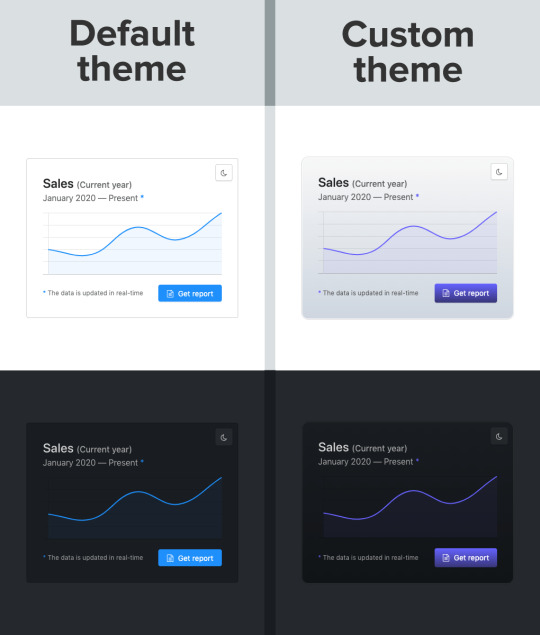
Swapping out a few custom property values opens up a ton of possibilities in Halfmoon, whether it’s theming things for a brand, or tweaking the UI to get just the right look.
That’s what we’re talking about here when it comes to customization: does the system still stand up and work well if the person using it overrides anything. I have written extensively about this (and much more) in the official Halfmoon docs page.
Variables aren’t a new concept to frameworks. Many frameworks actually use Sass or Less variables and have done so for quite a while. That’s still a good and effective way to establish a customizable experience. But at the same time, those will lock into a preprocessor (which, again, doesn’t have to be a bad thing). By relying instead on CSS custom properties — and variable-izing all the things — we are relying on native CSS, and that doesn’t require any sort of build dependency. So, not only can custom properties make it easier to customize a framework, but they are much more flexible in terms of the tech stack being used.
There is a balance to be had. I know I suggested creating variables for everything, but it can be equally tough to manage and maintain scores and scores of variables (just like anything else in the codebase). So, lean heavily on variables to make a framework or design system more flexible, but also be mindful of how much flexibility you need to provide and whether adding another variable is part of that scope.
Deciding what components to include
When it comes to building a CSS framework, deciding what components to include is a big part of that ordeal. Of course, for a developer working on a passion project, you want to include everything. But that is simply not feasible, so a few decisions were made on my part.
As of right now, Halfmoon has most of the components you can find in similar frameworks such as Bootstrap or Bulma. These frameworks are great and widely used, so they are a good frame of reference. However, as I have mentioned already, a unique thing about Halfmoon is the focus on building tools and dashboards on the web. This niche, if you could call it that, has led me to build some unique components and features:
5 different types of sidebars, with built-in toggle and overlay handlers. Sidebars are very important for most dashboards and tools (and a pain to get right), so this was a no brainer.
2 different types of navbars. There is one that sticks to the bottom of the page, which can be used to great effect for action buttons. Think about the actions that pop up when you select items on data-table. You could place those action buttons here.
Omni-directional dropdowns (with 12 different placements, 3 for each direction).
Beautiful form components.
Built-in keyboard shortcut system, with an easy way to declare new ones for your tool.
Tons of utilities. Of course, this is not comparable to Tailwind CSS, but Halfmoon has enough responsive utility classes to handle a lot of use cases right out of the box.
Moreover, the built-in dark mode, huge customizability, and the standard look and feel to the components, should all work together to make Halfmoon a great tool for building web tools and dashboards. And I am hopefully nowhere close to being done! The next updates will bring in a form validator (demo video), more form components, multi-select component, date and time picker, data-table component, etc.
So what is exactly missing from Halfmoon? Well the most obvious ones are tabs, list group, and spinners. But all of these are planned to be added in v1.2.0, which is the next update. There are also other missing components such as carousels, tree navigation, avatars, etc, which are slightly out of scope.
Providing user preferences
Giving end users the ability to set their preferences is often overlooked by frameworks. Things like setting the font size of an article, or whether to use a dark or light theme. In some ways, it’s sort of funny, because the web is catching up to what operating systems have allowed users to do for decades.
Here are some examples of user personalization on the web:
Being able to select your preferred color mode. And, even better, the website automatically saves and respects your preference when the page is loaded. Or better yet, looking at your operating system preferences and automatically accommodating them.
Setting the default size of elements. Especially font size. A small font might look good in a design, but allowing users to set their ideal font size makes the content actually readable. Technically, every modern browser has an option to zoom into content, but that is often unwieldy, and does not actually save your settings.
Setting the compactness of elements. For example, some people prefer large padding with rounded corners, while others find it a waste of space, instead preferring a tighter UI. Sort of like how Gmail lets you decide whether you want a lot of breathing room in your inbox or make it as small and tight as possible to see more content.
Setting the primary color on the website. While this is entirely cosmetic, it is still charming to be able to set your favorite color on every button and link on a website.
Enabling a high contrast mode. Someone pointed this out to me on GitHub. Apparently, many (and I mean many) CSS frameworks often fail the minimum contrast recommended between foreground and background colors on common elements, such as buttons. That list includes Halfmoon. This is often a tradeoff, because overly contrastive elements often look worse (purely in terms of aesthetic). User personalization can allow you to turn on a high contrast mode, if you have difficulty with the default contrast.
Allowing for user personalizations can be really difficult to pull off — especially for a framework — because that would could mean swapping out huge parts of CSS to accommodate the different personalization settings and combinations. However, with a framework like Halfmoon (i.e. built entirely using CSS variables), this becomes trivial as CSS variables can be set and changed on run-time using JavaScript, like so:
// Get the <html> tag (for reading and setting variables in global scope) var myElement = document.documentElement; // Read CSS variable getComputedStyle(myElement).getPropertyValue("--variable-name"); // Set CSS variable myElement.style.setProperty("--variable-name", "value");
Therefore, user personalization can be implemented using Halfmoon in the following way:
The user sets a preference. That basically means a variable value gets changed. The variable is set with JavaScript (as shown above), and the new value is stored in a cookie or local storage.
When the user comes back to the website, their preferences are retrieved and set using JavaScript (again, as shown above) once the page is loaded.
Here are visual examples to really hammer the point home.
Setting and saving the default font size
In the example above, whenever the range slider is changed, the variable --base-font-size is updated to the slider’s value. This is great for people who prefer larger text. As explained in the previous section, this new value can be saved in a cookie or local storage, and the next time the user visits the website, the user preference can be set on page load.
Setting the compactness of content

Because there are CSS custom properties used as utilities, like spacing and borders, we can remove or override them easily to create a more compact or expanded component layout.
Only two variables are updated in this example to go from an expanded view to a compact one:
--content-and-card-spacing changed from 3rem (30px) to 2rem (20px).
--card-border-radius changed from 0.4rem (4px) to 0.2rem (2px).
For a real life scenario, you could have a dropdown that asks the user whether they prefer their content to be Default or Compact, and choosing one would obviously set the above CSS variables to theme the site. Once again, this could be saved and set on page load when the user visits the website on their next session.
Wait, but why?
Even with all the examples I have shown so far, you may still be asking why is this actually necessary. The answer is really simple: one size does not fit all. In my estimate, around half of the population prefers a dark UI, while the other half prefers light. Similarly, people have wild variations about the things they like when it comes to design. User personalization is a form of improving the UX, because it lets the user choose what they prefer. This may not be so important on a landing page, but when it comes to a tool or dashboard (that one has to use for a long time to get something done), having a UI that can be personalized is a boon to productivity. And knowing that is what Halfmoon is designed to do makes it ideal for these types of use cases.
Moreover, you know how people often complain that websites made with a certain framework (eg Bootstrap) all look the same? This is a step toward making sure that websites built with Halfmoon will always look distinct, so that the focus is on the website and content itself, and not on the framework that was used to build it.
Again, I am not saying that everything should be allowed to be personalized. But knowing who the framework is for and what it is designed to do helps make it clear what should be personalized.
Looking ahead
I strongly feel that flexibility for customization and accounting for user preferences are often overlooked on the web, especially in the framework landscape. That’s what I’m trying to address with Halfmoon.
In the future, I want to make it a lot easier for developers to implement user preferences, and also promote diversity of design with new templates and themes. That said, here are some things on the horizon for Halfmoon:
A form validator (demo video)
New components, including range sliders, tabs and spinners
High contrast mode user preference
Multi-select component (like Select2, only without jQuery)
A date and time picker
A data-table component
A GUI-based form builder
More themes and templates
You can, of course, learn more about Halfmoon in the documentation website, and if you want to follow the project, you can give it a star on GitHub.
The post Considerations for Making a CSS Framework appeared first on CSS-Tricks.
You can support CSS-Tricks by being an MVP Supporter.
Considerations for Making a CSS Framework published first on https://deskbysnafu.tumblr.com/
0 notes
Text
Top 5 trending front end technologies should be used in 2020 and beyond
When it comes to front-end technologies, these are basically the types of technologies that developers leverage to craft user interface for websites, mobile apps, and web apps. As the name suggests, front-end technologies help developers create everything of software that appears in front of users. This is the reason why front-end technologies define the beauty and appearance of your website and applications, and thus, defines its market success. Be it drawing the attention of users to access your software or encouraging them to buy your offerings, these technologies play a vital role in this arena. So, while developing for your website or app for your business, you need to focus on the latest front-end technologies. And hire a website design company who is versed in the front-end technologies and leverage these by harnessing their unmatched potential. Like other technologies, the trend of using front-end technologies also changes yearly. Before we discuss here certain top-notch technologies that are trending in the year 2020, we are going to discuss here its various advantages.
Advantages of Leveraging Front-End Technologies for Web and App Development
Let’s discuss here some reasons why it is necessary for you to leverage these technologies for web and application development.
It automates the task
It gives developers the liberty to use elements and templates
It facilitates debugging and code optimization
Developers can improve their efficiency and productivity
It eases out the complications involved in the development process
Front-end Technologies that are in Trend in 2020
Let’s discuss here several front-end technologies that developers leverage to a wider extent to code a variety of websites and applications.
Vue.js
While talking about some trending front-end technologies in the year 2020, it’s good to start from none other than Vue.js, a popular JavaScript library. No matter what type of user interface you wish to have for your website or app, your developers can easily create the same with the use of this technology. The other great advantage of Vue.js is that its core library generally focuses on the view layer exclusively. So, your web designing company can easily make it possible to integrate the same with various other tools, libraries, etc. to get the desired outcomes. If you are looking for the right option to create a SPA (Single Page Application), Vue.js can be apt for you. You can make it possible by merging with some other libraries and tools. The growing popularity of Vue.js made it the stiff competitor of other technologies such as React and Angular.
Advantages
It comes with rendering support
One can keep eyes on the development process in real-time
It comes with a lower entrance threshold. So, you can grasp the Vue.js quickly compared to Angular
It can be easily integrated with HTML templates
React
React is another front-end technology that is in trend in the year 2020. As an open-source technology, React, a front-end library, was introduced in the year 2013. The most important thing about React is that it gets support from social media giant Facebook. The technology possesses the ability to break the code into two different components, which enable developers to get the advantage of code reusability and also debugging quickly. The software developed using React is responsive and good for search engine optimization.
Advantages
It brings the possibility for writing components
Improves productivity and maintenance
Fast rendering
Stable code
SEO-friendly
Angular
Angular is another technology that managed to retain its position in the list of some of the front-end technologies that are in trend in the year 2020. As the most reliable JavaScript front-end technology, Angular was launched in the year 2009 and witnessed its vast adoption among a number of developers for letting them create a wide range of UI designs. Since the inception of Angular, it has become the most preferred choice among developers for letting them avail of wide flexibility while creating a user interface of mobile and web applications. Enjoying vast community support, the front-end technology is maintained by none other than Google and ensures its effectiveness. Angular is famous among developers mainly for being easily readable, constant, and helps developers in creating performance-driven business apps. Another greatest benefit of Angular is that it is based on MVVM architecture, which makes it highly convenient for reflector and also for maintaining code in a proper way. Apart from this, it also gives complete assurance in terms of ease of test, top-quality coding, etc. for having component-based architecture.
Advantages
Vast community support
It facilitates two-ways data binding
It brings the possibility of web development with a mobile-friendly approach
It gets support by Google
Material design support
Flutter
Developed and introduced by Google, Flutter is an emerging open-source technology. It is most popular as a cross-platform development framework user interface development tool. It is useful for developers in creating top-notch and attention-seeking user interfaces for software. Programmed in Dart language, Flutter is the right option to craft a wide variety of UIs for different mobile and web applications. It uses a wide range of widgets when it comes to crafting enticing and also visually appealing user interface. The reason is that widgets are the most crucial part of apps and also front-end technology works effectively in offering full of compatibility. Apart from this, Flutter is also blessed with features like hot reloading, which accelerates the entire process of application development. With the use of this feature, developers can easily implement several changes in coding to apps even without reloading them. It renders amazing performance mainly because of less intervention between platform and app.
Advantages
It lets you implement same business logic and user interface across all the platforms
Minimize coding time
Increase time-to-market
Animated and customized user interface
Bootstrap
Last but not least, Bootstrap is another front-end technology that developers prefer to leverage to a wider extent. When it comes to code mobile-first and responsive websites, Bootstrap emerges as the right option for them. It is basically a combination of HTML, CSS, and JS frameworks. It lets developers use a predefined grid without any hustle. It also reduces their coding effort by minimizing it. Developers leveraging Bootstrap get entitled to availing of various benefits. Take a look at some of them.
Advantages
It minimizes developer’s coding effort for the grid
It is available with the in-built code that tends to resize images automatically no matter what is the current size of the screen.
Another great advantage of Bootstrap is that it consists of a set of components such as progress bars, navigation bars, thumbnails, dropdown, and many more. You will certainly not face any kind of difficulty when it comes to incorporating such important elements in your website pages.
Bootstrap comes with a large number of jQuery plugins that enable developers to create a highly interactive and also quite easy solution for image carousels, transition, etc.
Conclusion
After going through the above discussion, you are expected to have a clear understanding of various trending front-end technologies and their importance. So, while hiring a website and mobile app design company make sure they are blessed with enough expertise to implement these technologies while developing your software.
0 notes
Text
Identify the top 10 React carousel component libraries to enhance your web UI. Learn about their features, trends, and how to pick the right one for your project.
#React Carousel Libraries#React Slick#React applications#web applications#Hire dedicated React JS developer#web application development company#web application development service#web application agency
0 notes